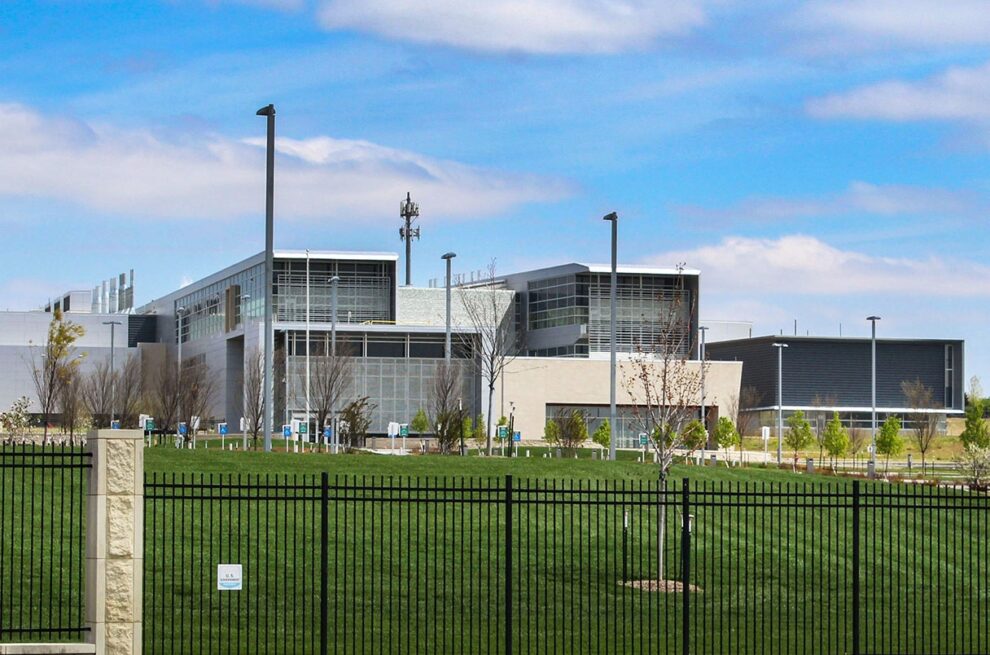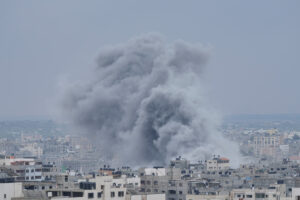Virologist Robert Cross’s lab is equipped to handle some of the world’s most dangerous viruses. At the Galveston National Laboratory he has worked with guinea pigs infected with Ebola virus and macaques carrying Lassa fever. What it can’t accommodate are pigs, which are common carriers of the deadly Nipah virus. “We’re not really geared to handle large animals,” says Cross, who wears a pressurized biosafety suit for his studies. “You can’t just pick them up when you’re wearing these space suits.”
That’s one reason why Cross is welcoming tomorrow’s ceremonial opening of a massive new high-security laboratory in Kansas, the first in the United States designed with pens and equipment such as cranes to move big animals tainted with the most hazardous infectious agents, including Nipah virus. Although active research won’t begin at the National Bio and Agro-Defense Facility (NBAF) in Manhattan for several years, Cross predicts that “a high containment resource to deal with agriculturally important pathogens … is going to change the [research] landscape.”
The laboratory, which will be operated by the U.S. Department of Agriculture, has taken nearly a decade longer to complete than planned and, at $1.25 billion, cost nearly three times as much as first predicted. It is also controversial. Although many researchers and powerful Kansas politicians have supported the project, some scientists, Manhattan residents, and farm groups have voiced concerns about handling pathogens dangerous to livestock and humans in the nation’s agricultural heartland. If a highly contagious animal disease escaped the lab, “it would just shut down commerce,” says Larry Kendig, a board member of the Kansas Cattlemen’s Association.
NBAF is intended to be the new home for work done for more than 60 years at the Plum Island Animal Disease Center, a federal laboratory on a tiny island in Long Island Sound, like an Alcatraz for diseases. Two decades ago Plum Island’s aging facilities and lack of the tightest biosecurity features prompted federal officials to start to plan an upgrade.
When New York state politicians opposed handling even more dangerous viruses on the island, the U.S. Department of Homeland Security (DHS), the lab’s overseer, looked elsewhere. It chose Manhattan, a town of 55,000 residents that is also home to Kansas State University. The agency cited broad community acceptance and the fact that Kansas was an emerging research hub for animal disease.
The new facility will have more than 53,000 square meters of floor space. Officials say staff will follow strict safety protocols and use specialized equipment, such as plastic “moon suits” with their own air supply. The features help make NBAF a biosecurity level-4 (BSL-4) lab, the most secure ranking. Plum Island, by comparison, is BSL-3. (NBAF will also house BSL-2 and BSL-3 laboratories.)
NBAF has equipment and rooms designed to handle large animals such as cows and pigs, enabling scientists to study diseases that are off-limits at Plum Island. That includes Crimean-Congo hemorrhagic fever, Japanese encephalitis, and Nipah, a virus carried by fruit bats that can sicken pigs and people, killing between 40% and 75% of human patients. The routes of infection are mysterious. “We don’t really understand what happens out on the farm in Asia where pigs are serving as amplifiers and spreading [the virus] to humans,” says Lisa Hensley, an epidemiologist and virologist who heads the NBAF unit that will conduct research on zoonotic and emerging diseases.
Being able to safely work with pigs could help reveal how Nipah virus spreads and help researchers develop countermeasures. “I can see a Nipah vaccine … being a high interest item in coming years,” says Cross, who is consulting with NBAF as it readies to open.
But some Kansans worry a pathogen could escape. “I don’t understand why you’d put a facility like that in the middle of a highly productive cattle and crops area,” says Kendig, whose ranch sits roughly 200 kilometers west of Manhattan. He and others have pointed to problems at other supposedly secure labs. In 2007, an outbreak of foot and mouth disease was traced to an animal health lab at Pirbright in the United Kingdom, where an investigation pointed to a leaking drainpipe. The highly contagious disease causes blisters on the tongue, lips, and between the hooves of cattle and other livestock, leaving animals debilitated and staunching milk production. That release affected just a handful of farms, but in 2001 U.K. officials had to order the killing of as many as 10 million animals to halt a much larger outbreak not related to a lab.
The decision to put NBAF “in the middle of livestock country and tornado alley was real hubris,” says Laura Kahn, a biodefense expert who worked at Princeton University’s Program on Science and Global Security for much of the past 2 decades.
She points to a 2010 DHS evaluation that found the Kansas lab would have a 70% chance of triggering an outbreak of highly contagious foot and mouth disease over 50 years. A later review by a U.S. National Academies of Sciences, Engineering, and Medicine panel concluded that study was incomplete. But it also blasted a second DHS study that pegged the risk at only 0.11%, saying it relied on “questionable and inappropriate assumptions” that likely understated the risk.
Yet former senior biosecurity official Gerald Epstein warns there’s also a danger to not having such a laboratory in an era of emerging infectious diseases. “I’m confident we know how to build this facility safely,” says Epstein, who was deputy assistant secretary of homeland security for chemical, biological, radiological, and nuclear policy under former Presidents Barack Obama and Donald Trump. (From 2009 to 2012, Epstein also directed a science and security program at AAAS, the publisher of Science.)
Hensley ticks off the safety measures that will be in place, but also points to a more personal gauge of her confidence: She moved to Manhattan with her teenage son to help run the lab. “I literally live several miles from the lab,” she says. “I have a tremendous amount of confidence in the team that I work with.”
Source : Science





































